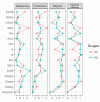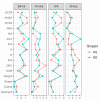A Multicenter Network Analysis Examining the Psychological Effects of the COVID-19 Pandemic on Patients with Eating Disorders versus Their Healthy Siblings
- PMID: 36498760
- PMCID: PMC9736149
- DOI: 10.3390/jcm11237187
A Multicenter Network Analysis Examining the Psychological Effects of the COVID-19 Pandemic on Patients with Eating Disorders versus Their Healthy Siblings
Abstract
(1) Background: The impact of the COVID-19 pandemic on individuals with eating disorders (EDs) has been recorded all over the world; the traumatic effects of COVID-19 have exacerbated specific and general psychopathologies in those with EDs. Comparing patients' and their healthy siblings' responses might help one evaluate whether there are significant differences between healthy individuals and those struggling with EDs in regard to posttraumatic psychological symptoms. (2) Methods: A sample of 141 ED patients and 99 healthy siblings were enrolled in this study in two different centers specializing in ED treatment. All participants completed the posttraumatic stress disorder (PTSD) checklist and an eating and general psychopathological self-report questionnaire. Network analysis was then applied to evaluate the differences between the populations. (3) Results: No significant differences emerged between the network structures despite the significant differences between patients and their healthy siblings in regard to posttraumatic symptoms, eating, and general psychopathology. (4) Conclusion: The complex nature of the interaction between environmental and personal factors should be evaluated further in individuals with EDs due to how they respond to traumatic events, which exacerbate patients' psychopathology.
Keywords: COVID-19; eating disorder; network analysis; posttraumatic; restraint; sibling.
Conflict of interest statement
The authors declare no conflict of interest.
Figures



References
LinkOut - more resources
Full Text Sources

